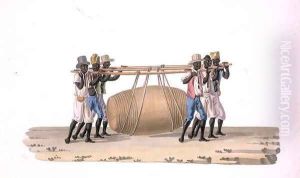Joaquim Candido Guillobel Paintings
Joaquim Candido Guillobel was a pivotal figure in the Brazilian art scene of the early 19th century, born in 1787 in Rio de Janeiro. His contributions are often noted for their historical and cultural significance during a transformative period in Brazil's history. Guillobel was primarily recognized for his work as a painter, draughtsman, and teacher, making significant strides in the development of Brazilian fine arts.
Guillobel's education and artistic development were deeply influenced by the European art scene, a common trend among Brazilian artists of his time who sought training and inspiration from the continent's artistic movements. Despite this European influence, Guillobel's work is distinctly Brazilian, often focusing on the landscapes, people, and burgeoning urban life of his homeland. His paintings and drawings provide a valuable visual record of Brazil's social and natural landscapes during the 19th century.
Throughout his career, Guillobel was deeply involved in the cultural milieu of Rio de Janeiro, the then capital of the Kingdom of Portugal, Brazil, and the Algarves, thanks to the Portuguese court's transfer in 1808. This period was marked by significant cultural exchange and the establishment of various institutions aimed at promoting the arts in Brazil, such as the Royal School of Sciences, Arts and Crafts, later known as the Imperial Academy of Fine Arts, where Guillobel was likely to have been affiliated.
Guillobel's legacy is marked by his dedication to capturing the essence of Brazilian identity through his art. His works served as an inspiration for future generations of Brazilian artists, contributing to the formation of a distinctly Brazilian artistic language. Despite the relative obscurity of his name in global art history, Guillobel remains a respected figure within Brazilian cultural heritage, celebrated for his role in documenting and shaping the visual narrative of Brazil's early 19th century.
Joaquim Candido Guillobel passed away in 1859, leaving behind a body of work that continues to be studied and admired for its historical and aesthetic value. His paintings and drawings are not only important for their artistic merit but also for their contribution to the understanding of Brazilian society and landscape during a period of significant change and development.

